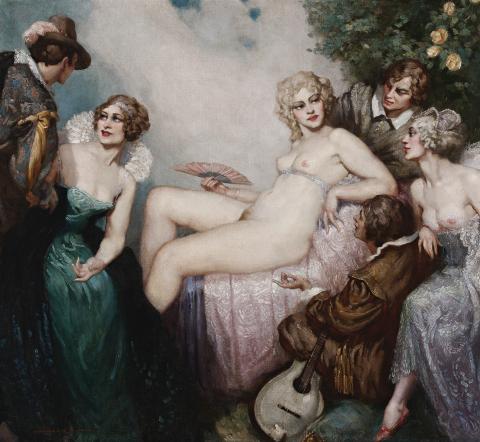THE LUTE PLAYER, c.1924
NORMAN LINDSAY
oil on canvas
91.5 x 100.0 cm
signed lower left: Norman Lindsay
Estate of the artist, Faulconbridge, New South Wales
Thence by descent
Private collection, Sydney
On long term loan to the Norman Lindsay Gallery - Springwood, Faulconbridge, New South Wales
Bloomfield, L., Norman Lindsay Oil Paintings 1889 – 1969, Odana Editions, New South Wales, 2006, pp.54 – 55 (illus.)
The Lute Player – Preliminary sketch for the oil painting, c.1924, pencil on paper, 18.0 x 21.5 cm, in the collection of the National Gallery of Australia, Canberra
The Lute Player, c.1924 is among the finest of Norman Lindsay’s oil paintings. A masterpiece of sensual beauty, it evokes the grandeur of a Titian nude. The pose recalls in part the Venetian master’s Venus with Cupid and a Lute Player of about 1562 in the collection of the Metropolitan Museum of Art, New York.1 And other Renaissance references abound in and through the presence of the lute, that long necked and full bodied instrument so favoured for secular music in those earlier times. Even Shakespeare was given to admiration when he gave Richard III the words of capering ‘…nimbly in a lady’s chamber to the lascivious pleasing of a lute’.2 Through the gifted hands of Lindsay, boldness is transformed into elegance, as the play of light on abundant flesh captures the eye, arousing the tactile senses and delighting in the amorous curves and gentle angles of the body. Grand in composition and painterly appeal, the indolence of gesture is effectively contrasted against the glistening fabrics.
Scholars debate a Neoplatonic interpretation of Titian’s several paintings of Venus accompanied by a musical instrument and its player, of the contest between the senses of sight and hearing as better suited to the appreciation of love. In his painting The Lute Player, Lindsay declares the victory of sight through the lute laid aside for the veneration of visual beauty, the player in supplicant position and admiration. Lindsay’s model is Rose, his wife and his Venus, posing for the central figure as well as the two ladies on either side. Three photographs are known of Rose posing, and the National Gallery of Australia, Canberra, has the composition drawing.3
Dark-haired Rose (1885 – 1978), was Lindsay’s second wife, a beauty of face and figure. As his most popular model, she appeared in his art for over twenty-five years. ‘Distinguished by her fine, pale skin, deep-set almond eyes, rosebud lips and luscious dark hair, Rose was an artist's model par excellence.’ 4 Before Lindsay, she had modeled for many of his artist-contemporaries including Julian Ashton, who introduced her to Lindsay, Sydney Long, Dattilo Rubo and Harold Cazneaux. Dry of wit and vivacious of temperament and appearance, who could resist her? Here crowned with a wig of blonde hair, in The Lute Player her presence is commanding, sovereign of visual beauty, celebrated and admired. As the musician casts aside his lute to bend his knee in honour of beauty, all are engaged in a conversation of gestures of indulgent invitation in a triumph of visual seduction.
In 2015 The Lute Player was the centre of attention at the Norman Lindsay Gallery and Museum, at Faulconbridge in the Blue Mountains, when Andrew Byrne, one of Australia’s leading exponents of the lute gave an evening recital in its presence. It shares its magnificence with another brilliant oil, Court to Peacocks, c.1924, painted to hang in Lindsay’s living room. Douglas Stewart once wrote excitedly of Lindsay: ‘He paints women as if they were goddesses’.5 With most of Lindsay’s major oils now in public galleries and museums, The Lute Player offers a rare opportunity for the discerning to enrich their collection.
1. Another version is in the Fitzwilliam Museum, Cambridge, UK
2. Shakespeare, W., Richard III, Act 1, Scene 1
3. Bloomfield, op. cit., p. 54
4. Carden-Coyne, A., ‘Lindsay, Rose’, Australian Dictionary of Biography, Supplementary Volume, Melbourne University Press, 2005
5. Stewart, D., The Flesh and the Spirit: an outlook on literature, Angus and Robertson, Sydney, 1948, p. 277
DAVID THOMAS
